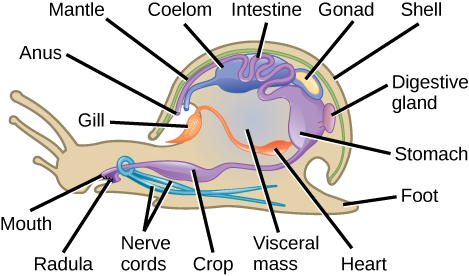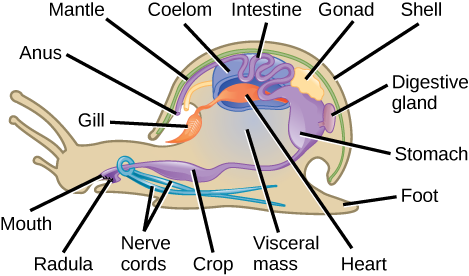Describe the morphology and anatomy of mollusks. Now one of the advantages of that is that it allows these organisms to be more flexible.

28 3e Phylum Mollusca Biology Libretexts
Describe the morphology and anatomy of mollusks.

. Molluscs with an oval shaped body and segmented plates of shells. 15 - Describe a potential advantage and disadvantage of. They are aquatic in nature.
Describe the morphology and anatomy of mollusks. All molluscs have a tissue that covers the animal called the mantle which is sometimes involved in shell secretion and respiration. 24-Explain why frogs are restricted to a moist environment.
23-What can be inferred about the evolution of the cranium and the vertebral column from examining hagfishes and lampreys. Have a general outline of what one looks like. To identify the different parts of a shellfish and describe the function of each part.
To understand the internal and external anatomy of a shellfish in detail. The annelids traditionally include the. Previous Post Previous Describe a potential advantage and disadvantage of the cuticle of ecdysozoans.
This cuticle is thinner and more flexible than a normal skeleton of an organism that makes their skeleton out of minerals and so that provides unique advantage. The mantle also secretes a shell containing chitin and conchiolin. To understand the internal organs and their functions.
15 - Describe the morphology and anatomy of mollusks. The most distinguishing feature of a mollusk is the presence of mantle having a cavity responsible for breathing and excretion. Figure 2820 Which of the following statements about the anatomy of a mollusk is false.
Two defining features are the mantle which secretes a protective calcareous shell in many species and the radula a rasping feeding organ found in most classes. The generalized mollusc is bilaterally symmetrical and has a single limpet -like shell on top. -The mantle encloses the mantle cavity which houses the gills excretory pores anus and.
A typical mollusk has. The digestive tract of the Mollusca is complex. They have a mantle a structure of tissue that covers and encloses the dorsal portion of the animal and secretes the shell when it is present.
The most distinguishing feature of a mollusk is the presence of mantle having a cavity responsible for breathing and excretion. A digestive gland is connected to the stomach. It includes animals like octopus squids and many others.
Fundamentals of Anatomy Physiology Plus Mastering AP with eText - Access Card Package 10th Edition New AP Titles by Ric Martini and Judi Nath Identify me theme or themes exemplified by a the sharp quills of a porcupine b the development of a multice. Describe the morphology and anatomy of mollusks. They are aquatic in nature.
-They have a mantle a structure of tissue that covers and encloses the dorsal portion of the animal and secretes the shell when it is present. Carnivorous mollusks usually have simpler digestive systems. Molluscs also have a unique set of feeding structures including the radula a chitinized strip that bears.
The tissue beneath the shell is called the mantle. 25-Describe three adaptations that allow for flight in birds. The number and form of radula teeth are highly.
And this volume has some features that characterize it. Describe the morphology and anatomy of mollusks. They have a variety of forms ranging from large predatory squid and octopus some of which show a high degree of intelligence to small grazing forms with elaborately sculpted and colored shells.
They have a mantle a structure of tissue that covers and encloses the dorsal portion of the animal and secretes the shell when it is present. Mollusks have a large muscular foot that may be modified in various ways such as into tentacles but it functions in locomotion. The opening of the shell aperture into which the animal can typically retract is often sealed with a horny sometimes calcareous operculum.
Some mollusks have evolved a reduced shell and others have no radula. The radula is usually used for scraping food such as algae from surfaces. The shell is secreted by a mantle covering the upper surface.
-a large muscular foot that may be modified into tentacles but it functions in locomotion. To study the life forms of shellfish with regard to their food and feeding habits age and growth followed by reproduction. Their foot functions as a suction cup to rocks and also for movement and they use their radula to eat algae.
Describe the morphology and anatomy of mollusks. Your email address will not be published. N Mollusks have a large muscular foot that may be modified in various ways such as into tentacles but it functions in locomotion.
Next Post Next Rank the following. Because they had this flexibility theyre thinner there lighter and so it can help. A pair of tentacles on the head containing chemical and mechanical sensors.
The digestive system includes a gizzard a stomach a digestive gland and the intestine. 15 - Sessile adult tunicates lose the notochord. Created by the gills.
They have a mantle a structure of tissue that covers and encloses the dorsal portion of the animal and secrete the shell when it is present. 15 - Compare the structural differences between. The mollusks are a diverse group 85000 described species of mostly marine species.
The shell is typically coiled usually dextrally the axis of coiling being around a central columella to which a large retractor muscle is attached. Mollusks have a radula for grinding food. It includes animals like octopus squids and many others.
And a pair of osphra reproductive systems two gonads. A pair of eyes on the head a pair of statocysts in the foot which act as balance sensors. The visceral mass or visceropallium.
Leave a Reply Cancel reply. Despite their amazing diversity all molluscs share some unique characteristics that define their body plan. The underside consists of a single muscular foot.
15 - Describe the feeding mechanism of sponges and. Mollusks have a large muscular foot that may be modified in various ways such as into tentacles but it functions in locomotion. 22-Describe the morphology and anatomy of mollusks.
15 - Speculate as to what advantages a complete. Human Anatomy Physiology. The foregut region consists of an esophagus and a mouth cavity which contains a toothed belt called the radula found in almost all mollusks and peculiar to the phylum.
And so lets look at the form and structure of a mollusc. Describe the morphology and anatomy of mollusks. Mollusks have a large muscular foot that may be modified in various ways such as into tentacles but it functions in locomotion.
And morphology and anatomy are all about the form and structure of an organism. Mollusks are the invertebrates that belong to the Phylum Mollusca. As you could tell it looks like a snail because snails air within the file um malice mollusc.
Mollusks can be divided into seven classes each of which exhibits variations on the basic molluscan body plan.

Mollusk Structure And Function Advanced Read Biology Ck 12 Foundation

14 13 Phylum Mollusca Biology Libretexts

Mollusks And Annelids Introductory Biology Evolutionary And Ecological Perspectives
0 Comments